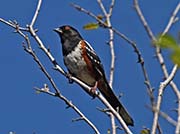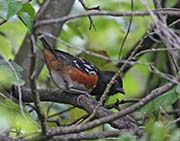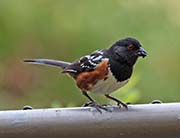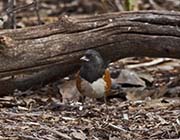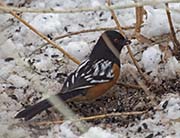Spotted Towhee - Pipilo maculatus
| Length | |
| Wingspan | |
| Weight | |
| Clutch Size | |
| Chicks at birth | |
| IUCN Conservation Status | |
Continents: |
Spotted Towhees are a large Emberizidae sparrow with a long-tail. Males are mostly black with rusty flanks, a white belly, and white spots on their mantle. They have red eyes, a round, chunky body, fan shaped tail, a short thick beak, and dull pink legs. Females are similar, but the black parts are mostly brownish or dusky black.
Spotted Towhees are difficult to spot because they spend a lot of time in dense bushes low to the ground. It is easier to find after you first hear them singing or buzzing or rustling around in the bushes.
Diet: Like other Towhees, Spotted Towhees double-scratch to find food. That is, a rapid backward kick with both feet at the same time. It is used to uncover insects, seeds and other potential food in leaf litter. They also forage in low branches for fruit and insects.
Courtship: The male will sing from the top of bushes to attract a female and defend their territories.
Nesting: The female Towhee builds the nest either on the ground or close to the ground. If on the ground, the nest is placed in a slight depression. The nest is made from dry leaves, stems, and bark strips and lined with grass, pine needles, hair, etc.
Each brood consists of 3-5 eggs. The young are altricial at birth and they will leave the nest after 10 to 12 days but are still feed by the parents.
Habitat and Range: They are found throughout most of the western U.S. and Northern Mexico. They prefer open, shrubby habitat with thick undergrowth but they can also be at home in backyards with lots of shrubs. They like areas where there is plenty of leaf litter to double-scratch in.
Vocalization: No information:
Plumage/Molt: No information:
Migration: Some Spotted Towhees migrate from places such as Washington, others are resident year round.
Tongue/feet: No information.
Bibliography:
- Beadle, David and J.D. Rising, Sparrows of the United States and Canada: A Photgraphic Guide,Rising, Academic Press, 2002
- http://www.birds.cornell.edu The Cornell Lab of Ornithology, Accessed June, 2012
- http://en.wikipedia.org The Free Encyclopedia, Accessed June, 2012
- http://birdweb.org/birdweb Seattle Audubon Society, Accessed June, 2012
